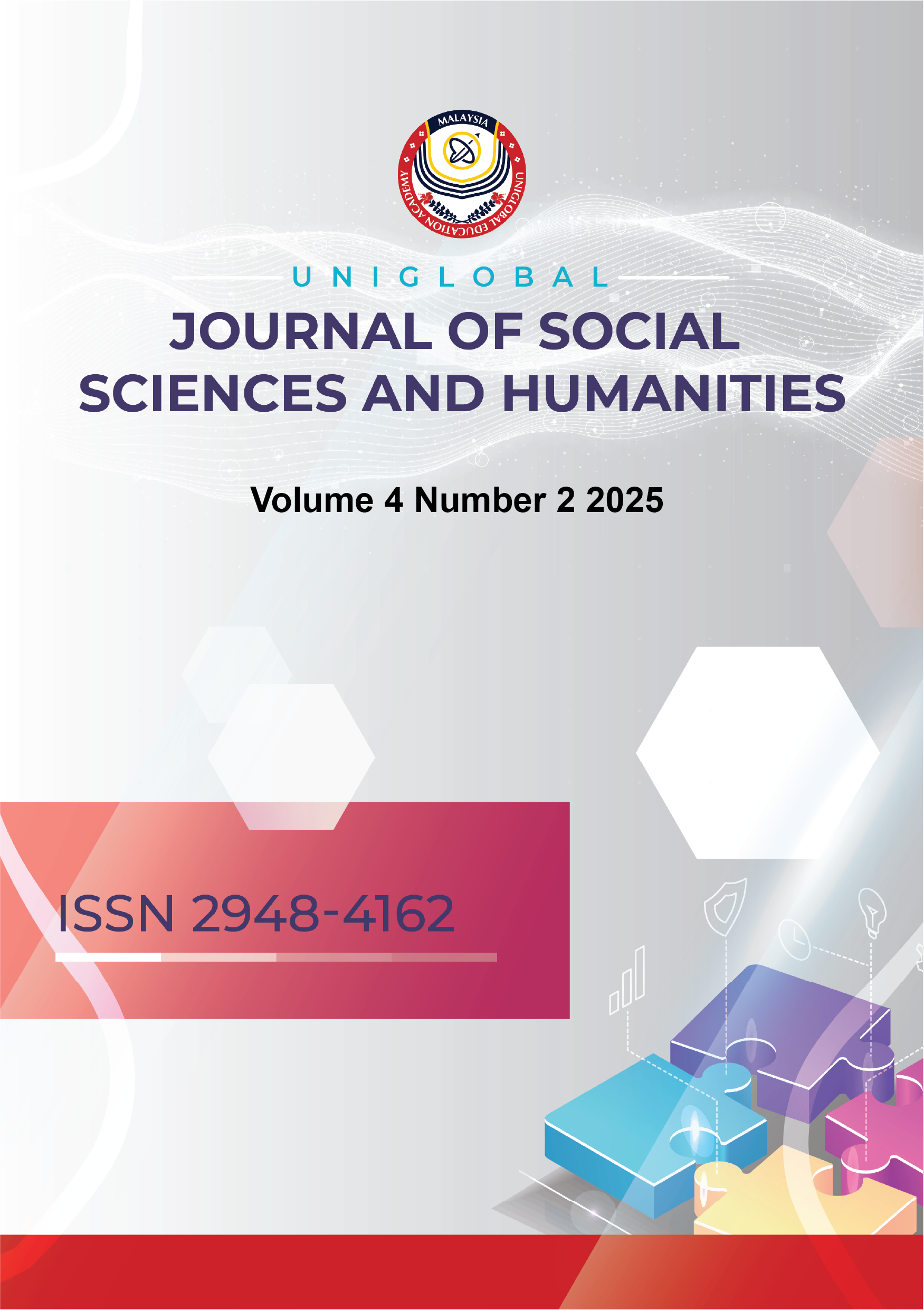Factors Influencing Student Loyalty in Online Physical and Health Education: Engagement and Satisfaction Effects
DOI:
https://doi.org/10.53797/ujssh.v4i2.16.2025Keywords:
Online physical education, student loyalty, student engagement, technological readiness, self-regulated efficacyAbstract
While online learning offers increased accessibility and flexibility, it presents unique challenges in traditionally hands-on subjects like physical education. Understanding the factors that influence student loyalty in online physical and health promotion education has become crucial for educational institutions seeking to maintain student engagement and retention in virtual learning environments. A quantitative research design employing Structural Equation Modeling (SEM) was conducted with 501 full-time undergraduate students from Heilongjiang International Studies University enrolled in online physical and health promotion courses. Data were collected using a validated 32-item Likert scale questionnaire measuring all six constructs. The study utilized purposive sampling and applied rigorous reliability and validity testing procedures, including exploratory and confirmatory factor analyses. The SEM analysis revealed significant positive relationships between Student Engagement and multiple factors: Student Technological Readiness (β = 1.141, p = 0.003), Self-regulated Efficacy (β = 1.897, p < .001), and Student Autonomy (β = 2.837, p < .001). Both Student Engagement (β = 0.991, p < .001) and Student Satisfaction (β = 1.003, p < .001) demonstrated strong direct effects on Student Loyalty. findings highlight the critical importance of fostering student engagement and satisfaction to enhance loyalty in online physical and health promotion education. The strongest relationship observed was between engagement and student autonomy, emphasizing the role of engagement in developing independent learning capabilities. These results provide valuable insights for educators and administrators to design more effective online physical education programs that prioritize interactive learning experiences and student-centered approaches to enhance retention and loyalty.
References
Ariantesa, B., Wahyuri, A. S., & Damrah, D. (2022). E-Module Development of Physical Education Subjects for Sports and Health on Physical Fitness Materials for Class VII Junior High School Students. International Journal of Education and Literature, 1(2), 37-43.
Azzi, D. V., Melo, J., Neto, A. D. A. C., Castelo, P. M., Andrade, E. F., & Pereira, L. J. (2022). Quality of life, physical activity and burnout syndrome during online learning period in Brazilian university students during the COVID-19 pandemic: a cluster analysis. Psychology, health & medicine, 27(2), 466-480.
Bandura, A. (1997). Self-efficacy: The exercise of control (Vol. 11). Freeman.
Centeio, E., Mercier, K., Garn, A., Erwin, H., Marttinen, R., & Foley, J. (2021). The Success and Struggles of Physical Education Teachers While Teaching Online During the COVID-19 Pandemic. Journal of Teaching in Physical Education, 40(4), 1–7. https://doi.org/10.1123/jtpe.2020-0295
Daud, Y. R., & Mohd Amin, M. R. (2023). Integrative conceptual framework of student loyalty, service quality, e-service quality and university image in open and distance learning. Higher Education, Skills and Work-Based Learning, 13(3), 560-574. https://doi.org/10.1108/heswbl-12-2022-0278
Elshami, W., Taha, M. H., Abdalla, M. E., Abuzaid, M., Saravanan, C., & Al Kawas, S. (2022). Factors that affect student engagement in online learning in health professions education. Nurse Education Today, 110, 105261. https://doi.org/10.1016/j.nedt.2021.105261
González-Calvo, G., Barba-Martín, R. A., Bores-García, D., & Hortigüela-Alcalá, D. (2022). The (virtual) teaching of physical education in times of pandemic. European Physical Education Review, 28(1), 205-224.
Idris, F., Zulkipli, I. N., Abdul-Mumin, K. H., Ahmad, S. R., Mitha, S., Rahman, H. A., Rajabalaya, R., David, S. R., & Naing, L. (2021). Academic experiences, physical and mental health impact of COVID-19 pandemic on students and lecturers in health care education. BMC Medical Education, 21(1). https://doi.org/10.1186/s12909-021-02968-2
Jang, D., Kim, I., & Kwon, S. (2021). Motivation and intention toward physical activity during the COVID-19 pandemic: Perspectives from integrated model of self-determination and planned behavior theories. Frontiers in psychology, 12, 714865.. https://doi.org/10.3389/fpsyg.2021.714865
Laar, R. A., Ashraf, M. A., Ning, J., Ji, P., Fang, P., Yu, T., & Khan, M. N. (2021). Performance, Health, and Psychological Challenges Faced by Students of Physical Education in Online Learning during COVID-19 Epidemic: A Qualitative Study in China. Healthcare, 9(8), 1030. https://doi.org/10.3390/healthcare9081030
Lee, K.-J., Noh, B., & An, K.-O. (2021). Impact of Synchronous Online Physical Education Classes Using Tabata Training on Adolescents during COVID-19: A Randomized Controlled Study. International Journal of Environmental Research and Public Health, 18(19), 10305. https://doi.org/10.3390/ijerph181910305
Mata, C., Onofre, M., Costa, J., Ramos, M., Marques, A., & Martins, J. (2021). Motivation and Perceived Motivational Climate by Adolescents in Face-to-Face Physical Education during the COVID-19 Pandemic. Sustainability, 13(23), 13051. https://doi.org/10.3390/su132313051
Mercier, K., Centeio, E., Garn, A., Erwin, H., Marttinen, R., & Foley, J. (2021). Physical Education Teachers’ Experiences With Remote Instruction During the Initial Phase of the COVID-19 Pandemic. Journal of Teaching in Physical Education, 40(2), 337–342. https://doi.org/10.1123/jtpe.2020-0272
Vilchez, J. A., Kruse, J., Puffer, M., & Dudovitz, R. N. (2021). Teachers and School Health Leaders’ Perspectives on Distance Learning Physical Education During the COVID ‐19 Pandemic. Journal of School Health, 91(7), 541–549. https://doi.org/10.1111/josh.13030
Wang, C., Omar Dev, R. D., Soh, K. G., Mohd Nasirudddin, N. J., Yuan, Y., & Ji, X. (2023). Blended learning in physical education: a systematic review. Frontiers in public health, 11, 1073423.
Webster, C. A., D’Agostino, E., Urtel, M., McMullen, J., Culp, B., Egan Loiacono, C. A., & Killian, C. (2021). Physical Education in the COVID Era: Considerations for Online Program Delivery Using the Comprehensive School Physical Activity Program Framework. Journal of Teaching in Physical Education, 40(2), 327–336. https://doi.org/10.1123/jtpe.2020-0182
Yang, S. (2021). Construction of Video Courses of Physical Education and Health Education in Colleges and Universities under the MOOC Platform. Mobile Information Systems, 2021, 1–8. https://doi.org/10.1155/2021/9925838
Yu, J., & Jee, Y. (2020). Analysis of Online Classes in Physical Education during the COVID-19 Pandemic. Education Sciences, 11(1), 3. https://doi.org/10.3390/educsci11010003
Yu, J.-E. (2022). Exploration of Educational Possibilities by Four Metaverse Types in Physical Education. Technologies, 10(5), 104. https://doi.org/10.3390/technologies10050104
Downloads
Published
How to Cite
Issue
Section
License
Copyright (c) 2025 Sen Zhang

This work is licensed under a Creative Commons Attribution-NonCommercial-ShareAlike 4.0 International License.



